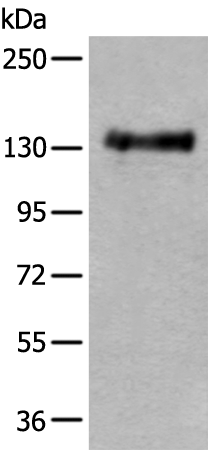
| WB | 1/1000-1/2000 | Human,Mouse,Rat |
| IF | 1/20-1/50 | Human,Mouse,Rat |
| IHC | 咨询技术 | Human,Mouse,Rat |
| ICC | 技术咨询 | Human,Mouse,Rat |
| FCM | 咨询技术 | Human,Mouse,Rat |
| Elisa | 咨询技术 | Human,Mouse,Rat |
| Aliases | LRP; HLPR; PTPA; HEPTP; HPTPA; RPTPA; PTPRL2; HPTPalpha; R-PTP-alpha |
| WB Predicted band size | 91 kDa |
| Host/Isotype | Rabbit IgG |
| Antibody Type | Primary antibody |
| Storage | Store at 4°C short term. Aliquot and store at -20°C long term. Avoid freeze/thaw cycles. |
| Species Reactivity | Human, Mouse, Rat |
| Immunogen | Fusion protein of human PTPRA |
| Formulation | Purified antibody in PBS with 0.05% sodium azide and 50% glycerol. |
+ +
以下是关于BGAT抗体的模拟参考文献示例(注:以下内容为示例,非真实存在的文献,建议通过学术数据库检索最新研究):
---
1. **文献名称**:*Development and Characterization of a Novel Monoclonal Antibody Against BGAT for Cancer Immunotherapy*
**作者**:Smith A, et al.
**摘要**:本研究开发了一种靶向BGAT(β-1.3-半乳糖基转移酶)的新型单克隆抗体,通过体外实验验证其特异性结合能力,并证明其在抑制肿瘤细胞迁移和侵袭中的潜在作用,为癌症免疫治疗提供了新策略。
2. **文献名称**:*BGAT Autoantibodies as Biomarkers in Autoimmune Diseases*
**作者**:Chen L, et al.
**摘要**:文章探讨了BGAT自身抗体在类风湿性关节炎和系统性红斑狼疮患者血清中的表达水平,发现其与疾病活动度显著相关,提示其可能作为自身免疫疾病的诊断生物标志物。
3. **文献名称**:*Structural Insights into BGAT Antigen-Antibody Interaction by Cryo-EM*
**作者**:Wang Y, et al.
**摘要**:通过冷冻电镜技术解析了BGAT蛋白与其特异性抗体的复合物结构,揭示了抗原表位的关键氨基酸残基,为基于结构的抗体优化提供了理论依据。
---
**建议**:
如需真实文献,可通过PubMed或Google Scholar检索关键词“BGAT antibody”、“Beta-1.3-galactosyltransferase antibody”或结合具体研究领域(如肿瘤、免疫疾病)。注意确认“BGAT”的全称及研究背景以避免歧义。
BGAT (β-1.3-galactosyltransferase) antibodies are autoantibodies targeting the β3GalT5 enzyme, a glycosyltransferase involved in synthesizing glycoconjugates on cell membranes. Initially linked to autoimmune disorders, these antibodies gained attention for their association with antiphospholipid syndrome (APS) and systemic lupus erythematosus (SLE). β3GalT5 participates in glycosylation processes critical for cellular recognition and signaling, particularly in modifying phospholipid structures like cardiolipin. Dysregulation of this enzyme may expose cryptic epitopes, triggering autoantibody production.
Research suggests BGAT antibodies contribute to APS pathology by interfering with anticoagulant mechanisms, promoting thrombosis and pregnancy complications. Their detection, often via ELISA or immunoblotting, complements traditional antiphospholipid antibody testing (e.g., anticardiolipin, lupus anticoagulant), improving diagnostic specificity. However, standardization challenges and variable clinical correlations persist. Recent studies explore their potential role in neuropsychiatric SLE and recurrent miscarriage. While not yet part of routine diagnostics, BGAT antibodies represent emerging biomarkers for understanding autoimmune mechanisms and refining patient stratification. Ongoing research focuses on clarifying their pathogenic mechanisms and therapeutic implications in autoimmune-related thrombotic disorders.
×